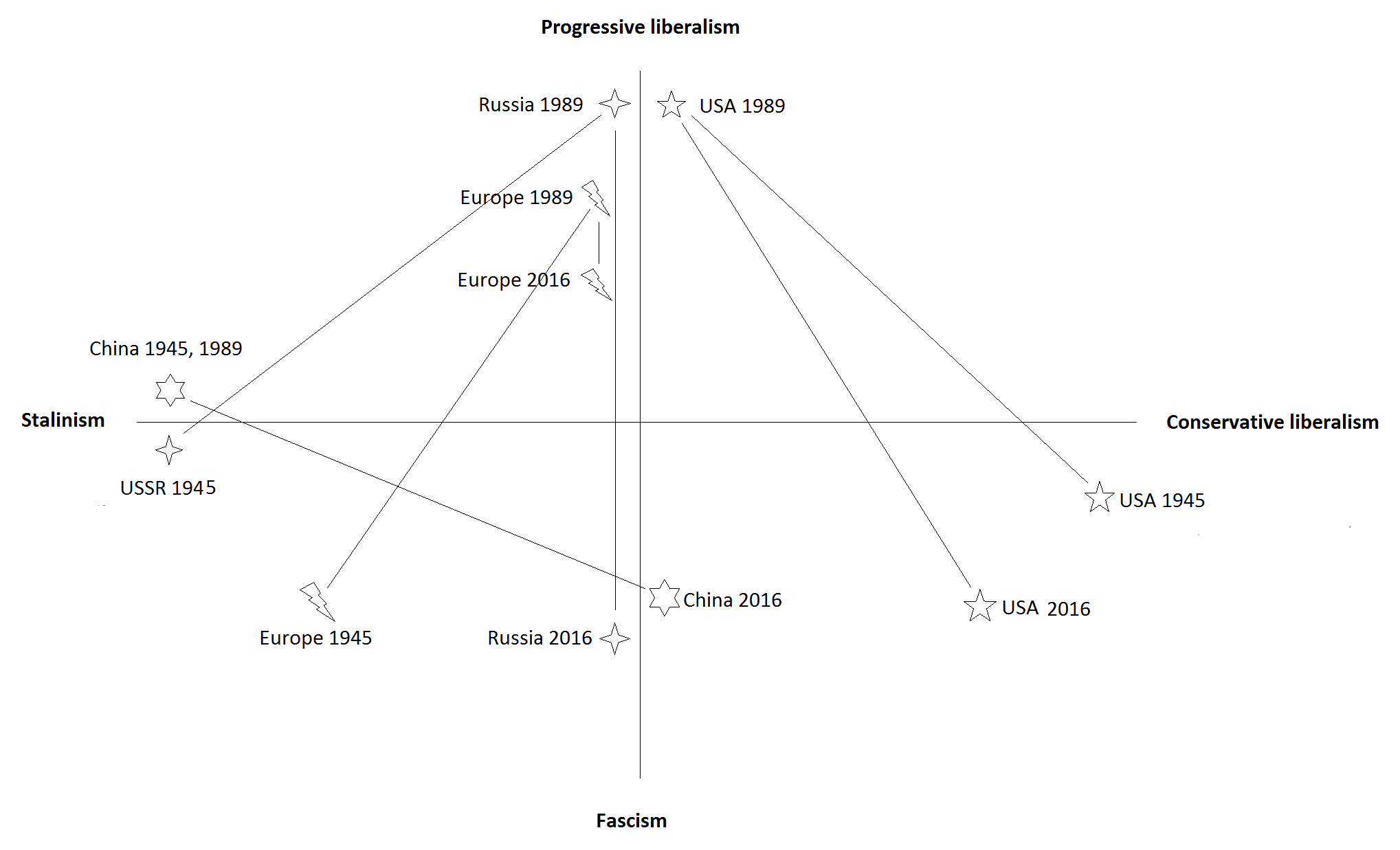1945, 1989, 2016…three years in the past century that changed everything.
Yes, that’s how big the de-globalisation revolution is in its impacts on ideology, politics and economics. It is a paradigm shift of the order of the end of WWII and the end of the Cold War.
History has this strange habit of sailing along without interruption before being ruptured with sudden change. We’re in one such moment today and Italy’s decisive rejection of its constitutional reforms is only the latest page in this new chapter following Brexit and Trump.
To help understand this landscape and what it means I’ve composed a couple of simple maps. The first is a table of the four political economy systems that have struggled for power since WWII worldwide:
| Progressive liberalsim | Conservative liberalsim | Fascism | Stalinsm |
| Market pricing | Market pricing | Rent-seeker pricing | Central planning |
| Open economic borders | Open economic borders | Closed economic borders | Closed economic borders |
| Open immigration | Closed immigration | Closed immigration | Closed immigration |
| Socially progressive | Socially conservative | Socially conservative | Socially conservative |
| Meritocractic | Patronistic | Nepotistic | Nepotistic |
| Democratic | Democratic | Oligarchic | Oligarchic |
| Post-military | Military | Martial | Martial |
| Post-modern | Modern | Post-truth | Post-truth |
The next is a map of where all of the major powers have moved since 1945:
As you can see, the basic political shift has been one from Stalinism in 1945 to Progressive Liberalism in 1989 and back towards various forms of Fascism in 2016. By that I mean rent-seeker controlled economies, Strongmen leaders with aligned oligarchs, closed immigration (and/or anti-multi-culturalism), protectionist, nepotistic, post-truth and socially conservative.
You can take your pick of how far each of the nations have moved but the thrust is basically right. In 1989 much of the free world jumped towards Progressive Liberalism. Yet in 2016, oligarchs rule in the USA, China and Russia on a continuum suspended somewhere between Fascism and Conservative Liberalism. Only Europe holds the Progressive Liberalism torch aloft today and it is under siege from internal and external Strongmen.
In terms of spheres of influence, the Germans will be no pushover but Russia will dominate Europe, China will dominate the Western Pacific and the USA the Eastern Pacific. Each will use the mechanisms of soft and hard power to do so, as well as more frequently, the tools of post-truth used apparently so successfully by Russia in the US election and by China across Asia in the past year.
So, what are Australia’s choices in this New World Order?
Traditionally, Australia has never moved to the bottom half of the ideological map. It has only ever bounced around in the top right quadrant. But today I would argue that it is closer to shifting towards Fascism than at any point in many decades, perhaps even the past century. The conditions are ripe for it in our oligarchic economy, political parties driven by power and elite business relationships, a shift towards prime ministerial centrism, a growing underclass deprived of income and housing, rising disenchantment with immigration (ironically driven by progressive blindness), a corrupt media and a mushrooming dependence upon a regional hegemon that is openly hostile to democracy. Moreover, our former hegemonic sponsor, the USA, has itself shifted materially towards Fascism (that is not to say that it is “facsist”, it’s not).
So, what are our choices? Must we follow any leader?
The fact is it is hard not to. Quite aside from cultural and political influence, owing to the rules and normatives of the international system, any serious change in orientation in the Great Powers filters inexorably down to middle powers and client states. For instance, if the US imposes a series of trade tariffs then other nations are likely to follow to protect their own production. Likewise, in military matters, changes in hard or soft power will influence everyone else. Hence we get ‘arms races’ and the like.
It is going to impact us, so which way should we go? I would argue, in Australia’s great centrist tradition, that we should aim to mitigate the risks of the extremes. To do this we will need policy-making that sustains the principles of liberalism while outflanking the extremes of Left or Right. The most obvious risk of Australia being drawn into the Fascistic gulf is an over-dependence upon China such that our allegiances with other liberal systems (albeit those shifted to more conservative standpoints) become meaningless. This is already happening by default so if we do nothing then it is probable that we will be drawn by China towards a Fascist future in which we get a Strongman leader anointed in Beijing, or manipulated into power using the tools of post-truth, and celebrated nationwide by a paid-off propertied class.
Thus MB recommends the following policy course for any political party that wishes to remain in power for the next decade without selling its soul:
- a big to cut the immigration intake and a rein on the “citizenship exports sector”;
- an overhaul of the Chinese investment regime such that it be placed alongside the nation’s strategic objectives;
- a ban on foreign political donations (where is it?) and a Federal ICAC;
- proper enforcement of rules governing foreign buying of real estate;
- a reboot of foreign policy that seeks a regional concert of powers to counter-balance China and engagement with the US much more heavily in Asia.
If these steps are not taken by a moderate leader then the scene will be set for someone more extreme to rise and shunt Australia towards a place that nobody in their right mind wants to go.

